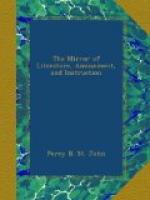* * * * *
FRENCH—ENGLISH LOVE.
The following is a copy of a letter addressed some years ago to a lady of fortune at Portsmouth, upwards of four score years of age, by a French prisoner of war at Porchester Castle:—
“Porchester.—Madam—Me rite de English very leet, and me very fears you no saave vat me speak; but me be told dat you vant one very fine man for your hosband; upon my soul me love you very well; and thou you be very old woman, and very cross, and ugly, and all de devil, and the English no like you, upon my soul we have one great passion for you, and me like you very well for all dat; and me told dat de man for you must be one very clen man, and no love de drink. Me be all dat: indeed me be one very grand man in France—upon my soul me be one count, me have one grand equipage in France, and me be very good for de esprit: indeed me be one grand beau-a-la-mode—one officier in de regiment: me be very good for de Engleterres. Indeed you be one very good old woman upon my soul; and if you have one inclination for one man, me be dat gentleman for you—one grand man for you. Me will be your hosband, and take de care for yourself, for de house, for de gardin, for de Schoff, for de drink, and for de little childs dat shall come. Upon my soul me kill myself very soon, if you no love me for this grand amour. Me be, madam, your great slave, votre tres humble serviteur, PRES A. BOIRE.”
W.G.C.
* * * * *
OLD LONDON BRIDGE.
It is well known that Peter of Colechurch, the founder of Old London Bridge, did not live to witness the completion of the structure, but died in 1205, and was buried in a crypt within the centre pier of the bridge, over which a chapel was erected, dedicated to St. Thomas-a-Becket. Mr. Brayley, in his Londiniana, wrote about five years since that “if due care be taken when the old bridge is pulled down, the bones and ashes of its venerable architect may still be found;”—and, true enough, the bones of old Peter were found on removing the pier about a fortnight since.
* * * * *
TAME LIONS.
Hanno, a Carthaginian, was the first who tamed a lion. He was condemned to death, for what his fellow-citizens considered so great a crime. They asserted that the republic had to fear the worst consequences from a man who had been able to subdue so much ferocity. A little more experience, however, convinced them of the fallacy of that ridiculous judgment. The triumvir Antony, accompanied by an actress, was publicly drawn by lions in a chariot.
SAD-USING.
* * * * *
CITY OF LYONS.
Lyons is situated on a sort of peninsula, formed by the confluence of two great rivers—the Rhone and the Laone. All the bridges, with the exception of one of stone, are of wood; and although in general more useful than ornamental, they are justly admired for the boldness of their construction. They form numerous and convenient communications between the city and the faubourgs.




